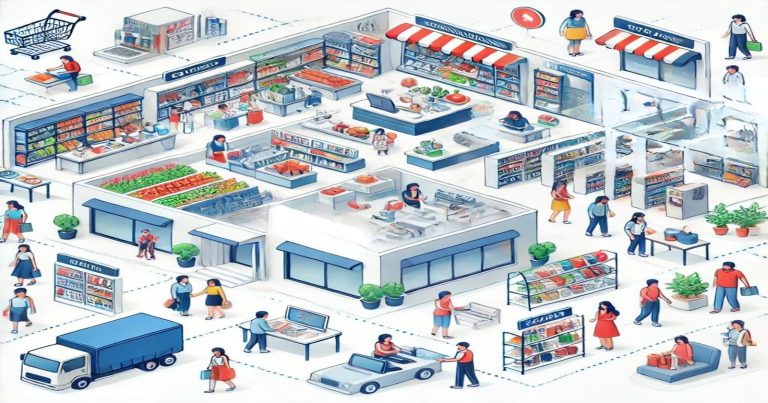A retail chain refers to a group of outlets owned, managed, and operated by the same company under similar products or services across multiple locations. In other words, the purpose behind the retail chain is to have a standardized shopping experience at all the outlets while still enjoying centralized management and procurement benefits along with brand recognition. In this article, let us look at what a retail chain is, its examples, advantages, and disadvantages, so the focus turns to the Indian markets.
What is Retail Chain?
A retail chain is a collective of retailing outlets with the same brand name, owning and managing setup. These shops are located geographically at places but have an identical product and store layout across all the chains, pricing policy, and a similar service delivered to the customer. Retail chains exist for groceries, apparel, electronics, etc. Some major retail chains in India include Big Bazaar, Reliance Fresh, D-Mart, and many more.
Types of Retail Chains
Retail chains are part of modern retail and supply chain management, allowing customers to find convenience, variety, and competitiveness in their retailing. There are some retail chain types.
- Department Stores: It sells all the varieties of products in one building. Example- Shoppers Stop: This has products divided into various sections, such as clothing, home products, and accessories.
- Supermarkets: Supermarkets focus on grocery and household products (Big Bazaar, D-Mart). It allows customers to buy in bulk with competitive pricing and self-service options.
- Speciality Stores: Sell unique products, like electronics or fashion. Examples: Croma, Pantaloons. They have expertise and offer a wide variety in one category.
- Convenience Stores: Small outlets for speedy purchases, like 7-Eleven and In & Out. They are located in busy areas and open for a more extended period.
- E-commerce Chains: Online stores with physical outlets or distribution centres (e.g., Amazon, Flipkart). They provide doorstep delivery, easy return, and a wide range of products online.
Retail Chain Examples
Retail chains are the norm in India and worldwide, representing grocery, fashion, electronics, and other types of businesses. A few examples of popular retail chains demonstrate how these companies work well across different locations.
Reliance Retail
In India, Reliance Retail is among the largest retail chains. It operates popular brands such as Reliance Fresh, Reliance Digital, and Trends. The stores sell products like groceries, fashion items, electronics, and more. Reliance Retail focuses on quality products to meet customers’ daily needs nationwide.
Big Bazaar
The future group will have a well-known retail chain, Big Bazaar. It offers daily essentials at affordable prices, mainly selling groceries, home products, and clothing to attract some shoppers looking for good deals and value-for-money goods.
D-Mart
D-Mart is a retail chain where minimum price competencies, such as discount pricing, are found. The range of products sold includes household commodities, groceries, and apparel. D-Mart focuses on the value offered through high-quality goods at low prices, making it a customer favourite for budget-conscious shoppers.
Croma
Croma is one of the largest electronics retail chains in the Tata Group and is positioned to sell gadgets, home appliances, and personal electronics products. A key feature of these stores is a wide range of the latest tech products, from smartphones to large appliances, all under one roof.
Advantages of Retail Chain
Retail chains are beneficial to businesses and consumers in many ways. They have big-scale and centralized operations, thus reducing costs and increasing efficiency.
Advantages for Businesses
Businesses benefit in so many ways, catapulting them to growth and success. These benefits improve efficiency, customer reach, and profitability.
- Economies of scale: Buying in bulk helps reduce the cost per unit. Helps negotiate better deals with suppliers.
- Brand Recognition: Powerful branding attracts a loyal customer. Consistent marketing strategies across all outlets enhance visibility.
- Operational Efficiency: Standardized operations and streamlined processes help to reduce errors and increase productivity with centralized management.
- Data-Driven Decisions: With the retail chain, data collection helps understand customer preferences. Data analysis improves product offerings and marketing strategies.
Advantages for Consumers
Well-established businesses have a few advantages when selling to consumers. Such advantages facilitate easy, inexpensive, and entertaining shopping.
- Ease: Accessing goods at any given place. Similar arrangements within stores help to facilitate the fast location of items.
- Affordable Prices: Purchasing several pieces simultaneously allows companies to give rebates. Sales and discounts take place regularly; therefore, these save consumers money.
- Wide variety: Available goods range within a single roof. Brands include both local and international.
- Trust and Honesty: Continuous quality and availability create confidence among consumers. In practice, return and refund policies.
- Positive Shopping Experience: Clean and transparent shops with supportive sales. Loyalty schemes and reward programs for loyal customers.
Disadvantages of Retail Chain
Despite their advantages, retail chains face specific challenges affecting businesses and customers.
Disadvantages for Businesses
With many benefits, retail chains also have problems that affect their growth and how it function. Here are some of the key disadvantages facing businesses in this sector.
- High Operating Cost: With multi-locations come the added cost of renting out utilities and staff salaries for each location, marketing, logistics, etc.
- Complex Management: Operating various regions is very hard. It has to be facilitated by an effective supply chain and communication system.
- Risk of Overexpansion: Expansion without a proper plan will likely result in loss. Difficult to maintain quality and service standards everywhere.
- Dependency on Supply Chain: Any disruption in the retail supply chain impacts all stores. Delays in inventory can lead to stockouts and lost sales.
- Stiff Competition: Competing with local businesses and other large retail chains. Has to innovate continuously to maintain its lead.
Disadvantages for Consumers
Retail chains provide convenience, but it also has drawbacks that affect consumer’s shopping experience. Some common disadvantages are discussed below.
- Lack of personal touch: retail chains are generally not as personal in service as a small, local store. Operations may not accommodate individual preferences with standardized processes.
- Price Uniformity: Fixed price without much scope for negotiation. Sometimes, local businesses may offer attractive deals during special seasons.
- Impact on Small Businesses: It can negatively affect the survival of small businesses as retail chains overpower local retailers. Leads to less diversity in regional markets.
- Limited Local Customization: Local preferences cannot be accommodated in some of the products. A focus on global trends prevents the specification of regional needs.
- Overcrowding in Stores: Popular retail chain stores become overcrowded, especially during sales. Long queues and waiting times during peak hours.
Retail Chain FAQs
1. What is retail chain?
A retail chain is a group of stores or outlets operated under one banner. Such a group of stores operated by one particular company in diverse locations.
2. What are the some of the well-known retail chains of India?
The well-known names are: Reliance Fresh, big Bazaar, d Mart, Crom, and many more.
3. Difference between Retail chain and a Retail Supply chain?
The network of stores is called a retail chain, and the process of sourcing, storing, and delivering products to these stores is called the retail supply chain.
4. What are the benefits of retail chain stores?
Some benefits include economies of scale, consistent brand experience, broad market reach, competitive pricing, and operational efficiency.
5. How does retail and supply chain management impact retail chains?
This implies effective retail and supply chain management, providing smooth flows, cost efficiency improvement, efficiency enhancement, and increased customer satisfaction.


